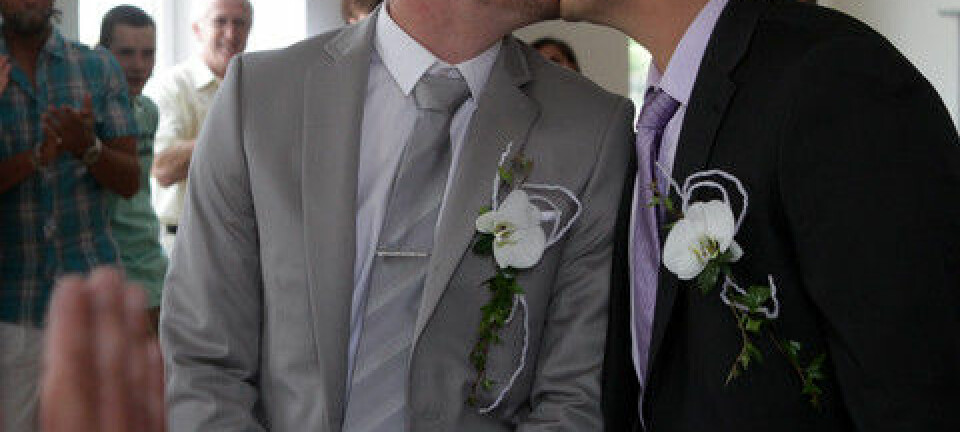An article from KILDEN Information and News About Gender Research in Norway

Gays forced to openness in the media
Gays and lesbians are forced to share their private lives as a lever in order to gain media attention.
Denne artikkelen er over ti år gammel og kan inneholde utdatert informasjon.
“If it were up to them [the media], they would know what I do in bed.” This is how “Jenny” describes one of her encounters with journalists in Elisabeth Eide’s study on gays’ and lesbians’ experiences with journalists and the media.
“It often becomes a tug-of-war between the problem in question and rights on the one hand and the intimate and private life on the other,” says Elisabeth Eide.
Eide is Professor of journalism at the Oslo and Akershus University College of Applied Sciences. She has studied Norwegian social commentators from the queer scene and their experiences of being defined by the media. She has also looked at how they adjust their message in order to gain media attention.
“It is like a partner dance where both parts want to lead, as is also the case with other relations between journalist and source.”
Privatisation of experiences
Eide’s article, which is published in Norsk Medietidsskrift (Norwegian Journal of Media), is based on six in-depth interviews with openly gay and lesbian people who over the last years have expressed themselves in the public media on topics related to sexual orientation.
The interviews were carried out as part of a larger research project at the University of Oslo. Within this project, Eide has also examined people of ethnic minority background and people with disabilities and their experiences with the media.
Like these groups, gays and lesbians also experience ambivalence in terms of having to draw the minority card in order to appear interesting to the media. And they feel pressured to share their private lives.
“The minority activists want to drag the journalist into a political sphere of demands. The journalists accept this in part, but they want to make the story more personal,” says Eide.
This often means that anyone who wants to draw attention to a cause through the media, who wants to set the agenda, has to put him or herself out there and give the journalists access to their own lives.
“It becomes a privatisation and intimisation of minority experiences.”
The victim role sells
The journalists are particularly interested in so-called confessional stories in their encounters with gays, lesbians and other queers. An example of such stories is how they “came out of the closet”: how it happened, reactions from family and friends, and “overcoming the lonely struggle”.
This type of stories often creates a dilemma for the interviewees. While these stories may be important to other people in a similar situation, they are also stories that the interviewees want to get away from. Another problem related to the confessional story is, according to Eide, that it emphasises the cost of being different.
“As long as you play the victim role, you automatically become ʻthe other’ compared to the heteronormative,” says Eide.
The term heteronormativity refers to the notion that heterosexuality is natural and normal, whereas other sexualities diverge from the norm.
“Some people find it legitimate to emphasise vulnerability. But consequently, this vulnerability becomes part of the abnormal.”
The same applies to what one of Eide’s interviewees calls “the language of pain”, namely stories about suicide and stories about AIDS related deaths. These are stories that “sell” in the media. But they also emphasise the victim role.
“You give away a part of your life”
Although Eide’s interviewees are critical towards the stories that the journalists want them to be part of, they also find it necessary to play along with the press in order to get their message across.
Instead, they express their resistance by setting clear limits to what they want to talk about in the media. They have a pedagogical attitude towards the press, and conscious media strategies.
On the one hand, they know exactly what to say in order to be published. Being private, appealing to emotions and the dominating frame stories are effective tools.
But at the same time, this type of media coverage also has its costs both for themselves and the message they want to get across. “You don’t always realise that by sharing something with the press, you give away a part of your life, […]”, says Geir. “It stays there forever.”
“Sometimes I’ve turned an old feminist doctrine around: ʻthe private is political’,” says Eide.
“This expression was meant to draw attention to the fact that issues such as domestic violence and rape are not private matters. But today you see that this type of intimacy can turn something political into something very unpolitical.”
Increasing diversity
The focus on the person and the private is deeply rooted within journalism as a discipline, and do not only apply to the coverage of issues related to minorities.
“You see it everywhere – the media has a tendency to make everything intimate,” says Eide.
“It has to do with a general urge for sensations, but it also shows a tendency to think that the public needs a personal story of suffering in order to understand the message.”
Eide carried out her interviews in 2009 and 2010, and she emphasises that incidents that have taken place during the last years, seem to have contributed to greater diversity and more general acceptance of gay stories and experiences.
“Since the time I collected my material for this article the diversity has increased in regard to sexual minorities. There is much more variation, but the media’s inclination to essentialise and emphasise intimate details is constant,” says Eide.
“But the development takes its course. That’s an optimistic punchline. The general acceptance and the variegation take its course.”


































